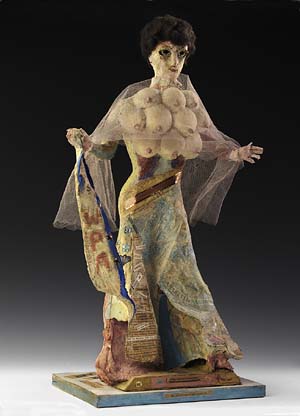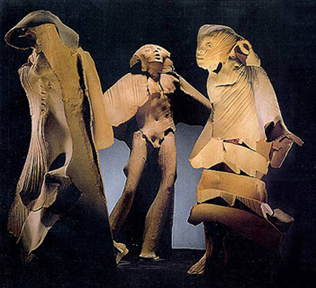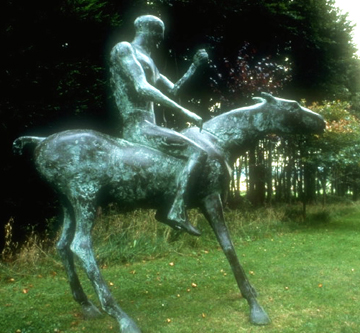 Eugenie Gershoy was born in Russia and was brought to New York City as an infant. By the time Gershoy moved to Woodstock, NY, in 1921 her individual style was already evident in her sculpture. Gershoy worked in stone, bronze, terracotta, plaster and papier-mache; her sculptures were mainly figurative and extemporized artist peers such as Carl Walters, Raphael and Moses Soyer, William Zorach and Lucille Blanch. From 1942 to 1966 Gershoy lived and painted in San Francisco where she taught at the San Francisco Art Institute. She traveled extensively, filling sketchbooks with scenes of Mexico, France, Spain, Africa and India. During her later years Eugenie Gershoy returned to New York City and concentrated on numerous well received exhibitions.
Eugenie Gershoy was born in Russia and was brought to New York City as an infant. By the time Gershoy moved to Woodstock, NY, in 1921 her individual style was already evident in her sculpture. Gershoy worked in stone, bronze, terracotta, plaster and papier-mache; her sculptures were mainly figurative and extemporized artist peers such as Carl Walters, Raphael and Moses Soyer, William Zorach and Lucille Blanch. From 1942 to 1966 Gershoy lived and painted in San Francisco where she taught at the San Francisco Art Institute. She traveled extensively, filling sketchbooks with scenes of Mexico, France, Spain, Africa and India. During her later years Eugenie Gershoy returned to New York City and concentrated on numerous well received exhibitions.
John Russell, former chief art critic at the New York Times, writes about the 1986 Sid Deutsch gallery exhibition: “As Eugenie Gershoy won the Saint-Gaudens Medal for fine draftsmanship as long ago as 1914 and since 1967 has had 15 papier-mache portrait figures suspended from the ceiling of the lobby of the Hotel Chelsea, she must be ranked as a veteran of the New York scene. Her present exhibition includes not only the high-spirited papier-mache sculptures for which she is best known but a group of small portraits of artists, mostly dating from the 30’s, that is strongly evocative.”
Pictured: Homage to Audrey McMahon, Goddess of Fertility, 1977
 Mary Frank, over the course of her artistic career, has worked in sculpture, painting, drawing, and printmaking. Her work has been collected by nearly every major American museum including The Hirshhorn Museum and Sculpture Garden, the Metropolitan Museum of Art, the National Museum of American Art, The Museum of Modern Art, The Whitney Museum of American Art and the Museum of Fine Arts in Boston.
Mary Frank, over the course of her artistic career, has worked in sculpture, painting, drawing, and printmaking. Her work has been collected by nearly every major American museum including The Hirshhorn Museum and Sculpture Garden, the Metropolitan Museum of Art, the National Museum of American Art, The Museum of Modern Art, The Whitney Museum of American Art and the Museum of Fine Arts in Boston. Elisabeth Frink was born in Thurlow, Suffolk, in 1930. One of Britain’s leading sculptors, Frink taught at the Chelsea School of art, and the Royal College of Art. She was awarded many honorary degrees and awards including the
Elisabeth Frink was born in Thurlow, Suffolk, in 1930. One of Britain’s leading sculptors, Frink taught at the Chelsea School of art, and the Royal College of Art. She was awarded many honorary degrees and awards including the